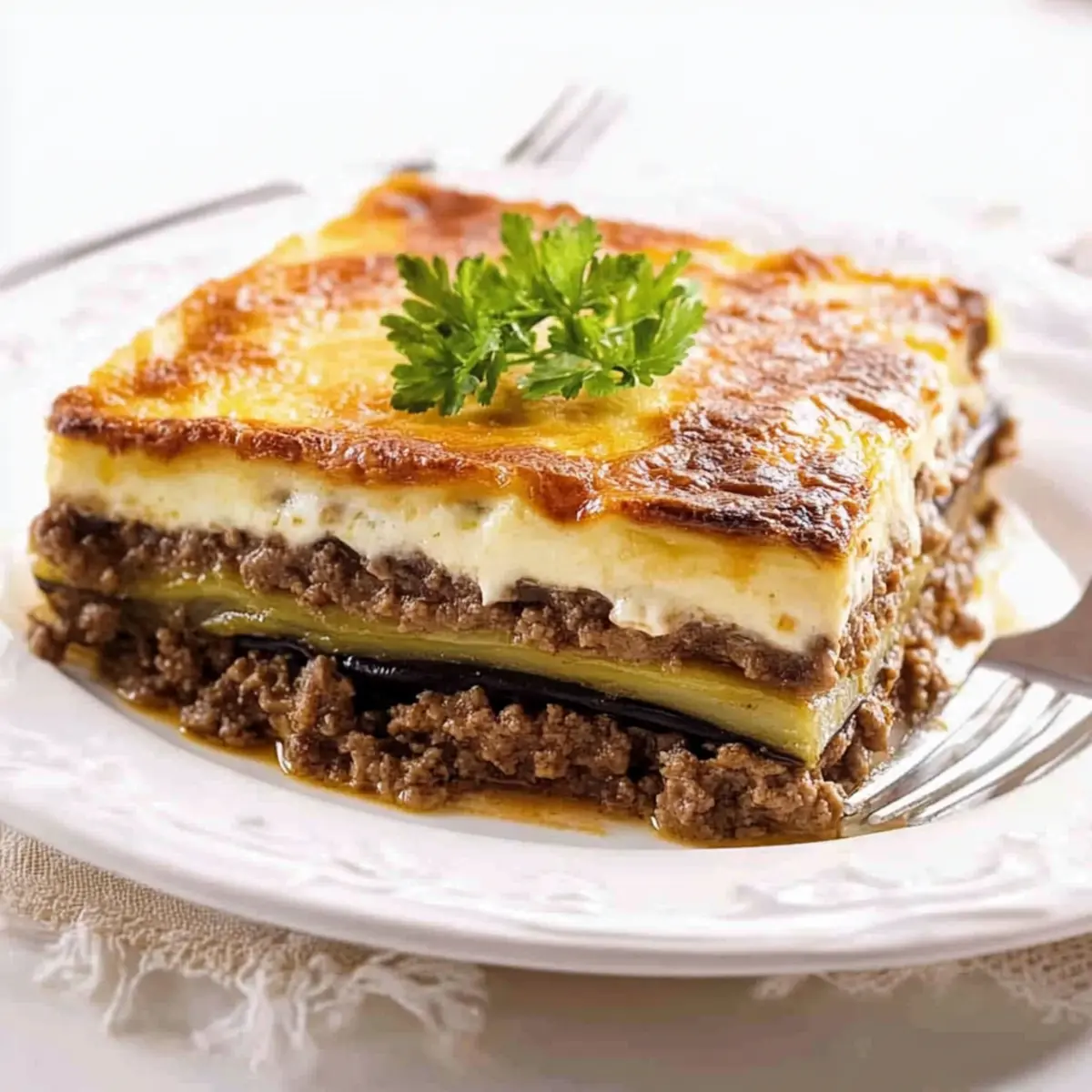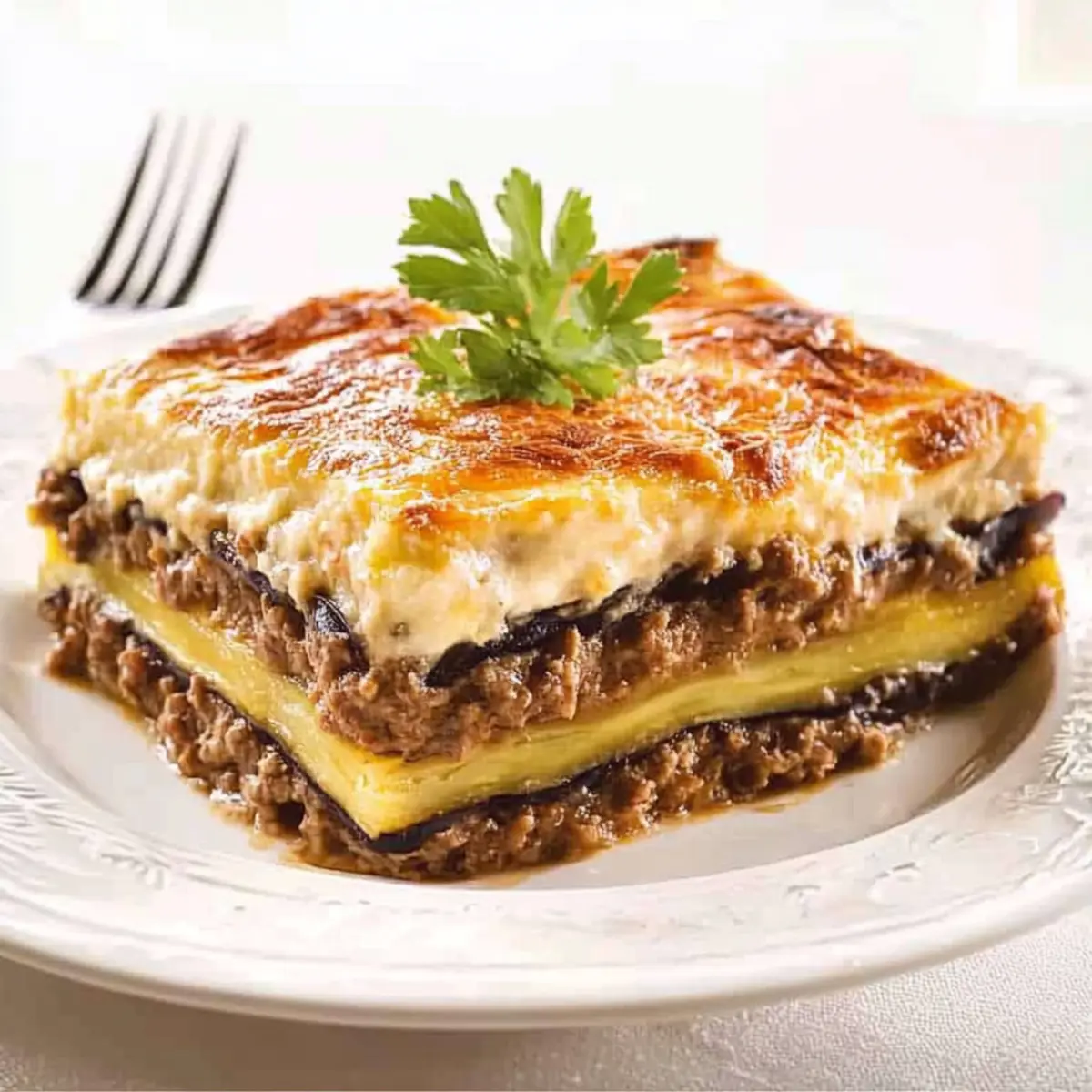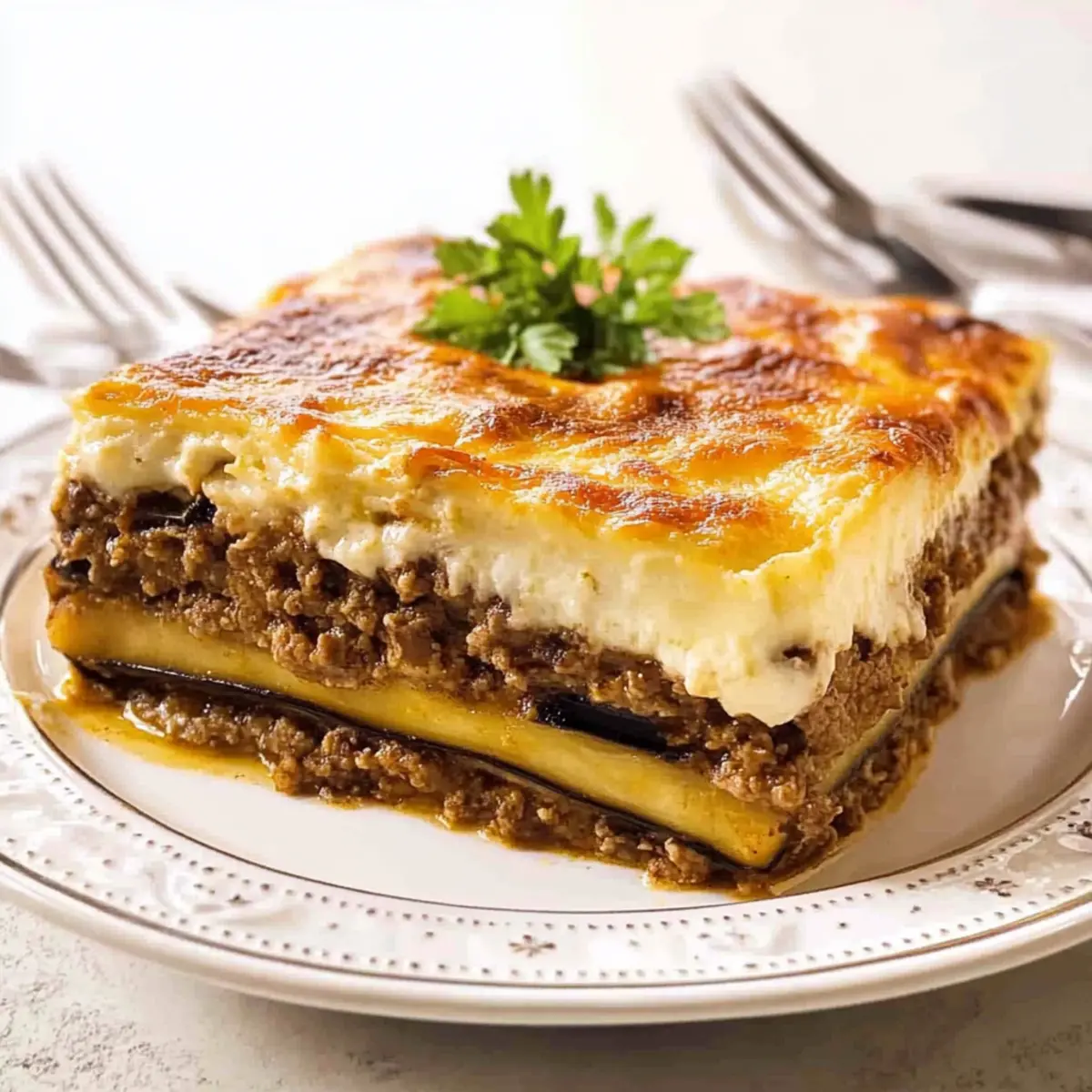The aroma of baked eggplant and spiced meat simmering in rich tomato sauce transports me straight to a sun-soaked terrace overlooking the Aegean Sea. With this Traditional Moussaka recipe, you can recreate that essence in your own kitchen, bringing a slice of Greece to your dinner table. This dish is not only a crowd-pleaser but also surprisingly easy to prepare, making it perfect for those special family gatherings or cozy weeknight dinners. Imagine savoring layer upon layer of tender eggplant, savory minced meat, and a creamy béchamel, all bringing comfort and satisfaction with every bite. Plus, with simple variations, you can cater to both traditionalists and vegan diners alike. Ready to embark on this delicious culinary journey? Let’s dive into making your own Moussaka masterpiece!

Why is Moussaka so beloved?
Authenticity: This Traditional Moussaka recipe captures the heart of Greek cuisine, bringing genuine flavors right to your table.
Ease of Preparation: With simple steps, even novice cooks can impress family and friends.
Versatile Options: You’ll love the ability to customize for all dietary preferences, including delicious vegan alternatives.
Crowd-Pleasing Appeal: A guaranteed hit at gatherings, its hearty layers delight palates young and old.
Cultural Experience: Each bite tells a story of Greek tradition, making meals memorable even beyond the dinner plate.
Explore a variety of serving suggestions to elevate your experience, including a refreshing Greek salad or tzatziki for dipping. Enjoy the journey as you create this delightful dish!
Traditional Moussaka Ingredients
For the Eggplant and Potatoes
- Eggplants (Aubergines) – Essential for layers and moisture; choose large, uniform sizes for even cooking.
- Potatoes – Creates a stable base; optional but recommended for authentic texture and flavor.
For the Meat Sauce
- Ground Meat (Beef or Lamb) – Provides richness and depth; traditional recipes use lamb, but beef or a mix works too. Vegan alternative: lentils or mushroom mix.
- Onions – Adds sweetness and builds the flavor base; use yellow or white onions for best results.
- Garlic – Freshly minced enhances the aroma and depth; don’t skip this key ingredient!
- Tomatoes (Chopped or Puree) – Acts as a flavorful liquid base; consider using fresh or canned without added sodium.
- Red Wine – Enhances flavor; omit for a non-alcoholic option or substitute with broth.
- Olive Oil – Ideal for cooking and lightly coating veggies before baking; opt for extra-virgin for the best taste.
For the Béchamel Sauce
- Butter – The base for the sauce; melt before adding flour for a smooth consistency.
- Flour – Thickens the béchamel; use gluten-free flour if needed for a gluten-free traditional moussaka.
- Milk – Adds creaminess; gradually whisk in for smooth texture; lactose-free milk can be used too.
- Cheese (Parmesan or Gruyère) – Brings richness to the béchamel; substitute with vegan cheese if desired.
- Egg Yolks – Adds thickness and richness; omit for a vegan béchamel.
- Nutmeg – Elevates the flavor beautifully; use sparingly to avoid overwhelming the dish.
Now that you have all the essential components, you’re ready to bring this traditional Moussaka to life!
Step‑by‑Step Instructions for Traditional Moussaka
Step 1: Prepare the Eggplants
Begin by slicing the eggplants into 1/2-inch thick rounds and sprinkling them generously with salt. Allow them to sit for about 30 minutes to draw out any bitterness. Afterward, rinse the slices under cold water, pat them dry with a kitchen towel, and set aside to prepare for baking.
Step 2: Bake Potatoes and Eggplants
Preheat your oven to 180°C (350°F). Next, toss the sliced potatoes and eggplant with olive oil, a pinch of salt, and pepper. Spread them in a single layer on a baking sheet and bake for approximately 20 minutes, or until they are slightly tender and just beginning to brown. This step is essential for achieving a flavorful texture in your traditional moussaka.
Step 3: Make the Meat Sauce
In a large skillet, heat a drizzle of olive oil over medium heat. Sauté finely chopped onions and minced garlic for about 5 minutes until they soften and turn translucent. Add the ground meat, season with salt and pepper, and cook until browned, about 10 minutes. Once browned, deglaze the pan with red wine, stirring to combine, then add in the chopped tomatoes. Let the mixture simmer for 15-20 minutes until it thickens.
Step 4: Prepare the Béchamel Sauce
In a saucepan over medium heat, melt the butter, then whisk in the flour to form a roux, cooking for about 2 minutes. Gradually add in the milk, whisking continuously until it thickens to a creamy consistency, about 5-7 minutes. Stir in the cheese, nutmeg, and egg yolks off heat, ensuring a rich béchamel sauce perfect for layering in your traditional moussaka.
Step 5: Assemble the Moussaka
In a greased baking dish, start layering your assembled moussaka. Begin with an even layer of baked potatoes, followed by half of the roasted eggplant slices, and then the meat sauce. Repeat the layering with the remaining eggplants, finishing with the creamy béchamel sauce spread thick on top.
Step 6: Bake
Place the assembled moussaka in your preheated oven and bake uncovered for about 60 minutes, or until the top is a beautiful golden brown and bubbly. The baking time allows all the flavors to meld beautifully, resulting in that classic, comforting taste of traditional moussaka that’s hard to resist.

Expert Tips for Traditional Moussaka
-
Perfect Eggplant Prep: Salt and let eggplants sit to draw out bitterness, ensuring a more pleasant flavor and texture in your traditional moussaka.
-
Layer with Care: When assembling, make sure to press down lightly on each layer to eliminate air pockets, resulting in a beautifully structured dish that holds together when served.
-
Béchamel Consistency: Whisk vigorously while adding milk to avoid lumps in your béchamel sauce; it should reach a custard-like thickness for the best topping.
-
Cooling Time: Allow your assembled moussaka to rest for at least 15 minutes before cutting; this helps the layers set and enhances flavor melding.
-
Storage Savvy: Store leftovers in an airtight container for up to 3 days. Reheat gently in the oven to maintain that warming comfort, pivotal to traditional moussaka.
How to Store and Freeze Traditional Moussaka
Fridge: Refrigerate leftovers in an airtight container for up to 3 days to maintain freshness and flavor.
Freezer: Freeze portions of moussaka in airtight freezer bags for up to 3 months. Thaw overnight in the refrigerator before reheating.
Reheating: Reheat in the oven at 180°C (350°F) for about 25-30 minutes. You can also microwave individual portions, ensuring they are heated thoroughly.
Assembly Tip: When freezing, it’s best to do so before baking, allowing you to enjoy freshly baked traditional moussaka on your schedule.
Traditional Moussaka Variations & Substitutions
Feel free to get creative with this Traditional Moussaka recipe; exciting twists await your kitchen adventures!
-
Gluten-Free: Substitute traditional flour in the béchamel with cornstarch or a gluten-free flour blend to ensure everyone can enjoy this dish.
-
Vegan Delight: Swap out the ground meat for a savory lentil mix or sautéed mushrooms, along with a creamy nut-based béchamel for a plant-based treat that everyone will love.
-
Lower-Carb: Replace potatoes with thinly sliced zucchini for a lighter twist that still retains that delicious layered essence. Zucchini will add moisture and a touch of sweetness.
-
General Flavor Boost: Add a sprinkle of fresh herbs like oregano or thyme into your meat sauce to elevate flavor profiles and infuse that classic Mediterranean aroma.
-
Cheesy Goodness: Stir some additional cheese into the béchamel, such as feta or ricotta, for a richer and more decadent sauce that complements the layers beautifully.
-
Spice It Up: For a bit of heat, mix in some crushed red pepper flakes or diced jalapeños with your meat sauce—we all love a little kick, especially when paired with the creaminess of the béchamel!
-
Nutty Twist: Incorporate toasted pine nuts or almonds within the layers for a delightful crunch and an unexpected surprise in each bite.
-
Layered Vegetables: Mix in some spinach or kale between layers, adding flavor and nutrition while making your moussaka vibrant and colorful.
Each variation can lead to a new family favorite, and while you’re here, don’t hesitate to serve it alongside a refreshing Greek salad or a cool bowl of tzatziki for dipping. Enjoy the adventure of creating your perfect Moussaka!
What to Serve with Traditional Moussaka?
Imagine a table brimming with vibrant flavors that perfectly complement the heartiness of your moussaka, creating a delightful feast.
- Greek Salad: A refreshing mix of cucumbers, tomatoes, and feta adds a crisp and tangy counterpoint to the rich moussaka.
- Tzatziki Sauce: This creamy yogurt-based dip, infused with garlic and cucumbers, brings a cooling element that balances the dish’s warmth.
- Pita Bread: Soft and warm pita is perfect for scooping up moussaka and tzatziki, adding a fun, interactive element to your meal.
- Roasted Vegetables: Seasonal roasted vegetables provide a lovely caramelization and natural sweetness, enhancing the layered flavors of the moussaka.
- Lemon Rice: Fluffy rice tossed with lemon zest adds a bright zing that beautifully harmonizes with the rich béchamel sauce.
- Wine Pairing: A glass of dry red wine, like a nice Chianti, complements the savory notes of the meat sauce, enriching your dining experience.
- Baklava for Dessert: End your meal with this sweet, flaky pastry. Its honey and nut sweetness perfectly contrasts the savory moussaka.
- Grilled Halloumi: Crispy on the outside and soft within, the salty cheese makes a heavenly addition that echoes Mediterranean flavors.
- Olives and Marinated Feta: These bites will enhance the meal’s Mediterranean essence while offering a delightful texture contrast through their briny goodness.
Make Ahead Options
These Traditional Moussaka are perfect for busy home cooks who want to save time without sacrificing flavor! You can prepare the eggplants and béchamel sauce up to 24 hours in advance; slice and salt the eggplants, then refrigerate them in an airtight container to prevent browning. The béchamel can also be made ahead and stored in the fridge. Cook the meat sauce and assemble your moussaka up to 3 days before baking; cover tightly and refrigerate. When you’re ready to serve, simply bake the moussaka straight from the fridge, adding an extra 10-15 minutes to the cooking time to ensure it’s heated through just as delicious as when freshly made!

Traditional Greek Moussaka Recipe FAQs
What kind of eggplants should I use?
When selecting eggplants for your traditional moussaka, look for large, uniform-sized eggplants, which provide an even cooking texture. Ensure they are firm and shiny, avoiding any dark spots or blemishes. If you’re looking for a lighter option, zucchini makes a great substitution!
How should I store leftovers?
Refrigerate any leftover moussaka in an airtight container for up to 3 days. This helps maintain its flavors and textures, allowing you to enjoy it just like the first serving. Simply reheat in the oven for a delightful experience.
Can I freeze traditional moussaka?
Absolutely! For optimal results, freeze your assembled moussaka before baking. Wrap it in plastic wrap and then foil to protect it from freezer burn, allowing it to stay fresh for up to 3 months. When you’re ready to enjoy, thaw it overnight in the refrigerator and then bake at 180°C (350°F) for about 60 minutes, until bubbling and golden!
What if my béchamel sauce gets lumpy?
If your béchamel sauce develops lumps, don’t worry! Simply whisk vigorously while gradually adding in the milk to break down the lumps. If it remains lumpy, you can also blend the mixture with an immersion blender until smooth. This process ensures a velvety consistency perfect for topping your moussaka!
Is this traditional moussaka suitable for allergies?
For those with gluten allergies, you can easily make a gluten-free traditional moussaka by substituting regular flour in the béchamel with cornstarch or a gluten-free flour blend. Additionally, you can use plant-based cheese and omit the egg yolks for a vegan variation without compromising flavor!
How can I incorporate more vegetables?
You can boost the vegetable content of your traditional moussaka by adding layers of spinach, kale, or even bell peppers. Not only does this enhance the nutrition, but it also adds delightful flavors to your dish. Just sauté them briefly before layering to maintain their color and texture!

Irresistible Traditional Moussaka Recipe to Savor at Home
Ingredients
Equipment
Method
- Slice the eggplants into 1/2-inch thick rounds and sprinkle generously with salt. Let sit for 30 minutes to draw out bitterness.
- Rinse the slices under cold water, pat dry, and set aside.
- Preheat the oven to 180°C (350°F). Toss the sliced potatoes and eggplant with olive oil, salt, and pepper. Spread in a single layer on a baking sheet and bake for about 20 minutes until slightly tender.
- In a large skillet, heat olive oil over medium heat. Sauté chopped onions and minced garlic for 5 minutes until soft.
- Add the ground meat, season with salt and pepper, and cook until browned, about 10 minutes. Deglaze with red wine, then add chopped tomatoes. Let simmer for 15-20 minutes.
- In a saucepan, melt butter, then whisk in flour to form a roux. Gradually add milk, whisking continuously until thickened, about 5-7 minutes. Stir in cheese, nutmeg, and egg yolks off heat.
- In a greased baking dish, layer baked potatoes, half roasted eggplant, meat sauce, remaining eggplants, and top with béchamel sauce.
- Bake uncovered for about 60 minutes until top is golden brown and bubbly.


